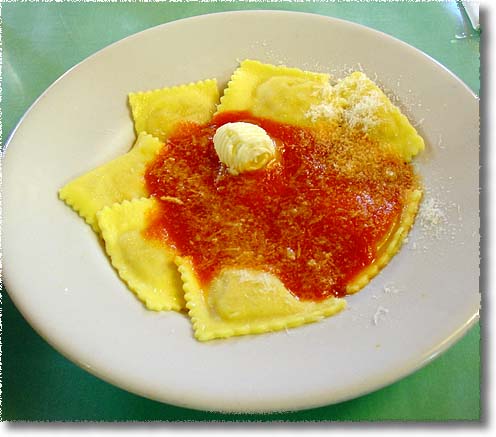Dino’s Marinara Sauce
A while back Dino Romano took me to task for linking to a modern Italian (in Italian) tomato sauce recipe that took liberties he was right to object to, saying:
“Even Neapolitans, known for some departures when it comes to plain tomato sauce, wouldn’t use parsley and oregano AND onion mixed with garlic in a sauce.
“I’ve noticed over the past ten or fifteen years that the ‘younger’ generation of Italian food writers have begun to truly bastardize so much of traditional Italian cooking that it has come to look and sound like the convoluted workings seen on American television cooking programs. Now THAT is a shame.
“A very traditional recipe (prepared in the best kitchens, both North and South in Italy) for ‘Marinara,’ a word which is indeed derived from that fact that a sailor or Marinaro would easily cook this meatless dish on board ship, was prepared virtually daily at our farm in Lexington, MA when we were growing up. One version included the entire tomato, and the other pureed tomatoes with the seeds and skin removed. It was best when our eleven acres of trellis tomatoes were in season. We moved from Sicily to the U.S. in the early sixties and my father farmed until just a couple of years ago. My cousins are still farming the same land, which was recently pegged by an historian as having been farmed continuously since the early 1700’s.”
And here are the marinara sauces he sent me
The whole tomato recipe first:
- Ten pounds of VERY ripe tomatoes
- Garlic
- Olive Oil
- Salt
- Sugar
- Black Pepper
- Fresh Basil
- Pecorino Romano Cheese, grated
- Pasta
Chop the washed tomatoes into small cubes (to reduce the area and cooking time).
Sautée ten or fifteen large garlic cloves in olive oil until they are dark golden.
Add chopped tomatoes and bring to a boil, stirring constantly to avoid burning or sticking.
Pour in an additional quarter cup of oil (or more according to taste).
Add salt, a heavy dusting of black pepper and about three tablespoons of sugar (depending on the acidity of the tomato you can use less or no sugar).
Lower heat to medium and cook uncovered, stirring regularly, until all fluid is thickened. THIS SHOULD NOT TAKE FOUR HOURS BUT MORE LIKE A HALF HOUR. Why people insist on torturing tomato sauce on a stove for half a day is beyond me — we call it the “Nonna syndrome.”
Remove from heat and immediately add a large quantity of fresh chopped basil.
Cook pasta extra al dente and drain.
Add pasta back to pan and add five or six ladles of tomato sauce to the pasta and stir over a medium heat until sauce and pasta are thickened.
Serve each plate with an additional ladle full of sauce on top and a drizzling of fresh cold olive oil and a heaping of Pecorino Romano.
The Pureed Tomato Version:
Same as above except that initially you cut tomatoes in half, put into a large pan and heat until softened, not necessarily boiling.
Run all the heated tomatoes through a Foley Food Mill to remove skin and seeds. It is important to run the tomato skins back through the mill three or four times to get all the richness out of them. This is where the flavor is.
This mixture may be utilized immediately to make the above Marinara or stored in the refrigerator to be used as needed to make a completed sauce of any type marinara or meat sauce.
It can also be jarred immediately and stored for over a year. It is important to put a large sprig of basil into the unadulterated puree before sealing.
O.K., hope I haven’t offended anyone by putting my two cents worth in. Keep up the great work.
Regards,
Dino Romano
When I asked Dino for permission to publish his recipes, he replied,
“Please feel free to publish my recipe for simple ‘marinara.’ You might want to add that there is a parallel, sister version to this recipe where the garlic is NOT browned but put in completely raw. The method with which one introduces garlic makes for completely different flavor in just about any dish. Another version of garlic introduction to this marinara is fresh, uncooked garlic introduced with the fresh basil at the end.”
What more can I say, other than Grazie Dino! Actually, I can say something more: Dino has begun to work with The Pasta Channel, and presents a version of his Marinara Sauce beginning with canned tomatoes (preferably without citric acid added), which will be perfect when sun-ripened tomatoes are not available.


